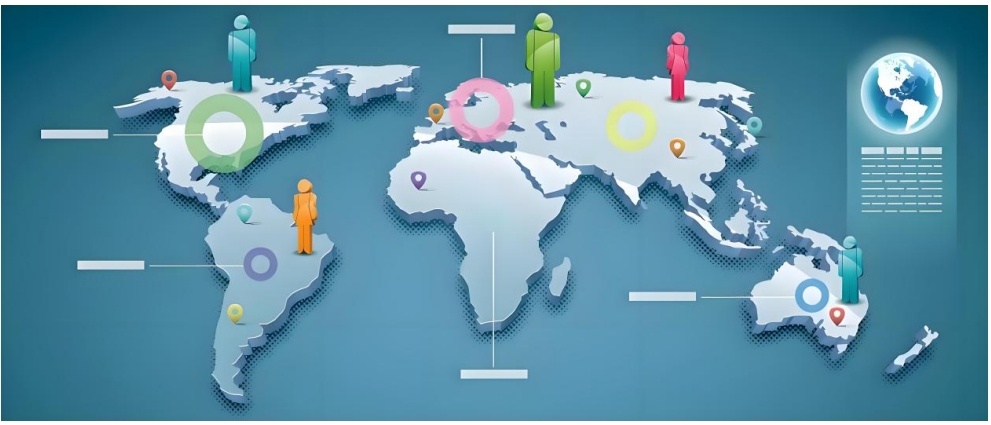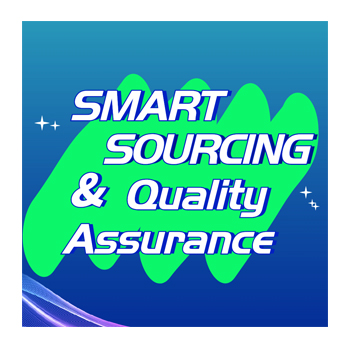
The concept of global sourcing services
Global sourcing service is a supply chain service for procurement and product integration that transcends national boundaries.
Procurement companies (generally speaking, enterprises with certain capabilities) utilize global resources to search for suppliers worldwide, seeking products with the best quality and reasonable prices. They integrate these resources advantageously to provide a procurement platform that combines cost leadership and product resource coverage advantages.
Global sourcing services also involve the comprehensive integration of supply chain links such as product development, raw material procurement, manufacturing, and marketing, providing a platform for global buyers, retailers, brand owners, and product providers in China and around the world to supply goods, integrate and customize products, and conduct transactions.
Global sourcing services focus on cost advantages and emphasize the extensive coverage of product sources.
The business scope of global sourcing services is extensive, covering multiple fields such as chemical industry, IT storage equipment, and electronic products, serving large enterprises such as Toshiba, Lenovo, Tongfang, Sinopec, and PetroChina.
The core process of global sourcing services
The core process of global sourcing services usually includes the following key steps:
1. Requirement confirmation and analysis
Clearly define procurement objectives: Enterprises first need to clarify their own needs for products or services, including quantity, specifications, quality standards, and delivery requirements. Market research: Through market research, understand the supply situation, price trends, supplier information, etc. in the international market, find potential suppliers and assess market conditions, providing a basis for subsequent procurement decisions.
2. Selection and Evaluation of Suppliers
Supplier Search: Utilize various channels (such as industry exhibitions, online platforms, recommendations from professional organizations, etc.) to identify potential suppliers and select the most suitable one. The choice of supplier directly impacts procurement costs, supply capacity, and product quality.
Selection and Evaluation: Conduct selection and evaluation based on factors such as suppliers' price, quality, delivery capability, and after-sales service. This usually involves the inspection of qualifications, production capacity, quality control systems, and other aspects.
Negotiation and Confirmation: Negotiate with the selected supplier to determine key terms such as purchase price, delivery date, and payment method, and sign a purchase contract.
3. Signing and execution of procurement contracts
Contract signing: Clarify the rights and obligations of both parties, including key terms such as delivery date, price, quality standards, and liability for breach of contract.
Procurement execution: Place purchase orders to suppliers according to the contract and supervise the delivery status of suppliers. This includes tracking order progress, handling delivery delays, and ensuring that the purchased products or services meet the requirements stipulated in the contract.
4. Quality Inspection and Receiving
Quality inspection: Conduct quality inspection on the products or services delivered by the supplier to ensure that they meet the quality standards agreed upon in the contract.
Receiving and Warehousing: Coordinate transportation, warehousing, and inventory management. After passing the quality inspection, the products or services are received and warehoused.
5. Payment and Settlement
Payment arrangement: Arrange payment matters according to the contract, including the payment of deposit, balance, etc.
Settlement and Recording: Conduct settlement after payment is completed, and properly and accurately record relevant financial information.
6. Post-management and Evaluation
Supplier management: Establish long-term cooperative relationships with suppliers, conduct regular evaluations and feedback (including inspection of delivery quality), continuously improve service levels, ensure that the quality of purchased goods or services meets expectations, and establish long-term partnerships with suppliers.
Procurement Performance Evaluation: Conduct performance evaluation of the procurement process, including evaluation of indicators such as procurement costs, delivery punctuality, and product quality, in order to optimize and improve procurement strategies. Continuously track supplier performance and address any issues to maintain standards.
7. Risk Management and Response
Risk identification: Identify potential risk points throughout the procurement process, such as exchange rate fluctuations, political risks, supply chain disruptions, etc.
Risk Assessment and Response: Evaluate the identified risks and develop corresponding response measures and contingency plans to reduce the impact of risks on the enterprise.
The core process of global sourcing services requires enterprises to conduct refined management and control in multiple aspects to ensure the smooth progress of procurement activities and the achievement of procurement goals.
What are the risks in global sourcing services?
In global sourcing services, enterprises face a variety of risks, which may stem from different links in the supply chain and changes in the external environment.
Below are some descriptions of the main risks in global sourcing services, hoping to provide assistance to everyone.
1. Supplier Risk
Unstable suppliers: Global sourcing involves cooperation with suppliers from different countries and regions. Suppliers may become unstable due to political turmoil, natural disasters, economic crises, and other reasons, leading to procurement interruptions or delays.
Quality risk: Suppliers in different countries and regions may adopt different quality standards, making it difficult for purchasers to ensure the consistency of the quality of the purchased products or services, which affects the quality of the final products or services.
Intellectual Property Risk: In global sourcing, the ownership and protection of intellectual property is a significant issue. The purchaser may face disputes over intellectual property infringement, leading to legal proceedings and financial losses.
2. Price and Exchange Rate Risk
Price fluctuation: Fluctuations in market prices may lead to increased procurement costs, affecting the execution of procurement plans and cost control.
Exchange rate fluctuation risk: Global sourcing involves transactions in multiple currencies, and fluctuations in exchange rates may lead to an increase or decrease in procurement costs, affecting the financial stability of the purchaser.
3. Logistics and Transportation Risks
Transportation Delays: Global sourcing involves cross-border or cross-regional logistics and transportation, which may result in transportation delays due to factors such as weather, traffic congestion, and political instability, affecting the purchaser's production plans and delivery schedules.
Transportation damage: During the logistics and transportation process, goods may be damaged or lost due to traffic accidents, theft, customs inspections, and other reasons, resulting in financial losses and production interruption risks for the purchaser.
4. Political and Legal Risks
Political system risk: Due to political changes in some countries, trade policy and regulations are constantly being revised, which may lead to trade operators bearing a lot of risks brought by political changes, such as tariff measures and non-tariff measures.
Regulatory Differences and Compliance Risks: Laws and regulations in different countries and regions may vary, including contract law, labor law, environmental protection law, etc. Purchasers need to understand and comply with local laws and regulations, otherwise they may face legal proceedings and fines. In addition, global sourcing also involves compliance requirements such as anti-corruption, anti-money laundering, and social responsibility.
5. Cultural and Communication Risks
Language and cultural risks: Global sourcing involves different cultures, languages, moral values, and business practices from various countries and ethnicities, which may lead to communication barriers or deviations, affecting the stability of cooperation between both parties.
Communication barriers: Due to geographical locations, time zone differences, and other reasons, communication between the purchaser and the supplier may be poor, affecting procurement efficiency and quality.
6. Other risks
Excessive hidden costs: In addition to direct procurement costs, global sourcing may also involve additional costs such as tariffs, transportation insurance, communication expenses, etc. Hidden costs may increase the total procurement cost.
Lack of Professional Talent: Global sourcing requires procurement personnel with professional knowledge and skills, but many companies may lack such talent, leading to problems in the procurement process.
The risks in global sourcing services are diverse, and enterprises need to comprehensively assess these risks and formulate corresponding countermeasures to ensure the smooth progress of global sourcing and the steady development of enterprises.
Global Sourcing Service Development Trend
The development of the procurement market has been deeply intertwined with digitalization and intelligence. In the future, global sourcing services will be influenced by various factors, showing a trend of diversification and complexity.
Here are some trends for the future development of global sourcing services:
Digitalization and Intelligence
With the continuous development of information technology, digital procurement management will become mainstream. Enterprises will achieve the digitalization and automation of procurement processes through advanced procurement management software, improving procurement efficiency and transparency. The digital procurement management platform will integrate supplier information, purchase orders, inventory management, and other data, achieving full-process visibility and traceability.
Artificial intelligence and machine learning technologies will play an increasingly important role in global sourcing services. Through big data analysis and intelligent algorithms, enterprises can optimize procurement decisions, predict market demand, and reduce inventory costs. For example, conversational AI can help procurement personnel quickly retrieve supplier information and organize negotiation strategies.
Supply Chain Optimization
Enterprises will pay more attention to the flexibility and resilience of the supply chain, and reduce risks through diversified supply chain management. Supply chain optimization will include supplier performance evaluation, inventory management optimization, logistics and transportation efficiency improvement, etc., in order to achieve efficient operation and cost savings of the supply chain.
Offshore outsourcing
With the changes in geopolitics and trade environment, nearshore outsourcing and local procurement will become important trends. Companies will be more inclined to seek suppliers in neighboring regions to reduce logistics costs and shorten delivery cycles. At the same time, local procurement also helps companies better understand local market demand and cultural differences, improving product adaptability and competitiveness.
Sustainable procurement
As consumers' awareness of sustainability and environmental issues continues to rise, sustainable procurement is set to become a major trend in global sourcing services. Companies will pay more attention to the environmental and social impact of their procurement activities, opting for suppliers and products that adhere to sustainable development principles. For instance, they will encourage suppliers to adopt renewable energy sources and eco-friendly materials.
Moral compliance trend
Moral compliance will continue to be emphasized in global sourcing services. Enterprises need to ensure that suppliers comply with relevant laws, regulations, and industry norms, avoiding moral risks such as child labor and forced labor. Enterprises need to strengthen the transparency of the supply chain and ensure effective management and supervision of suppliers.
Combination of globalization and localization
Despite the obvious trend of nearshore outsourcing and local procurement, the global sourcing network will still maintain its importance. Companies will continue to utilize global resources to find the best suppliers and product combinations to achieve cost savings and quality improvement.
While engaging in global sourcing, enterprises will also pay more attention to local service support. By establishing local teams and partnerships, enterprises can better understand local market demands and cultural differences, and provide customized product and service solutions.
Technological innovation
New technologies such as blockchain and the Internet of Things (IoT) will play an increasingly important role in global sourcing services. For example, blockchain technology can improve supply chain transparency and reduce the risk of fraud; IoT technology can achieve real-time inventory management and logistics tracking.
Pattern innovation
With the intensification of market competition and the diversification of consumer demands, the global sourcing service model will continue to innovate. For example, new procurement models such as on-demand procurement and crowdsourcing procurement will gradually emerge, providing enterprises with more flexibility and choice.
Global sourcing services will continue to innovate and develop in multiple aspects such as technology, management, and cooperation models, providing enterprises with more efficient, flexible, and sustainable procurement solutions.

Smart Sourcing Content Team
Article by Smart Sourcing Content Team
The Smart Sourcing Content Team is committed to delivering high-quality, easy-to-understand information that helps our audience navigate the complexities of global sourcing. Our team of writers has extensive experience in producing articles across various fields such as procurement, supply chain management, market trends, and industry best practices. We specialize in sectors like apparel, textiles, and consumer goods, providing targeted insights to help businesses in these industries optimize their sourcing strategies and stay competitive.
Grow your business with TradeAider Service
Click the button below to directly enter the TradeAider Service System. The simple steps from booking and payment to receiving reports are easy to operate.



